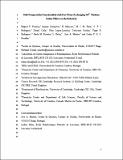Por favor, use este identificador para citar o enlazar a este item:
http://hdl.handle.net/10261/112874COMPARTIR / EXPORTAR:
 SHARE SHARE
 CORE
BASE CORE
BASE
|
|
| Visualizar otros formatos: MARC | Dublin Core | RDF | ORE | MODS | METS | DIDL | DATACITE | |

| Título: | Gold nanoparticles functionalised with fast water exchanging Gd3+ chelates: linker effects on the relaxivity |
Autor: | Ferreira, Miguel F.; Calle, Daniel CSIC ORCID CVN; López-Larrubia, Pilar CSIC ORCID; Cerdán, Sebastián CSIC ORCID; Rodrigues, Tiago B. CSIC; Helm, Lothar; Martins, José A.; Geraldes, Carlos F. G. C. | Fecha de publicación: | 2015 | Editor: | Royal Society of Chemistry (UK) | Citación: | Dalton Transactions 44(9): 4016- 4031 (2015) | Resumen: | The relaxivity displayed by Gd3+ chelates immobilized onto gold nanoparticles is the result of the complex interplay between the nanoparticle size, the water exchange rate and the chelate structure. In this work we study the effect of the length of ω-thioalkyl linkers, anchoring fast water exchanging Gd3+ chelates onto gold nanoparticles, on the relaxivity of the immobilized chelates. Gold nanoparticles functionalized with Gd3+ chelates of mercaptoundecanoyl and lipoyl amide conjugates of the DO3A-N-(α-amino)propionate chelator were prepared and studied as potential CA for MRI. High relaxivities per chelate, of the order of magnitude 28-38 mM-1 s-1 (30 MHz, 25 °C), were attained thanks to simultaneous optimization of the rotational correlation time and of the water exchange rate. Fast local rotational motions of the immobilized chelates around connecting linkers (internal flexibility) still limit the attainable relaxivity. The degree of internal flexibility of the immobilized chelates seems not to be correlated with the length of the connecting linkers. Biodistribution and MRI studies in mice suggest that the in vivo behavior of the gold nanoparticles was determined mainly by size. Small nanoparticles (HD = 3.9 nm) undergo fast renal clearance and avoidance of the RES organs while larger nanoparticles (HD = 4.8 nm) undergo predominantly hepatobiliary excretion. High relaxivities, allied to chelate and nanoparticle stability and fast renal clearance in vivo suggest that functionalized gold nanoparticles hold great potential for further investigation as MRI contrast agents. This study contributes to a better understanding of the effect of linker length on the relaxivity of gold nanoparticles functionalized with Gd3+ complexes. It is a relevant contribution towards >design rules> for nanostructures functionalized with Gd3+ chelates as Contrast Agents for MRI and multimodal imaging. | Descripción: | et al. | Versión del editor: | https://doi.org/10.1039/C4DT03210A | URI: | http://hdl.handle.net/10261/112874 | DOI: | 10.1039/C4DT03210A | Identificadores: | doi: 10.1039/C4DT03210A issn: 1477-9226 e-issn: 1477-9234 |
| Aparece en las colecciones: | (IIBM) Artículos |
Ficheros en este ítem:
| Fichero | Descripción | Tamaño | Formato | |
|---|---|---|---|---|
| Gd3mas.pdf | 2,73 MB | Adobe PDF |  Visualizar/Abrir |
CORE Recommender
WEB OF SCIENCETM
Citations
14
checked on 24-feb-2024
Page view(s)
433
checked on 16-abr-2024
Download(s)
274
checked on 16-abr-2024
Google ScholarTM
Check
Altmetric
Altmetric
NOTA: Los ítems de Digital.CSIC están protegidos por copyright, con todos los derechos reservados, a menos que se indique lo contrario.
